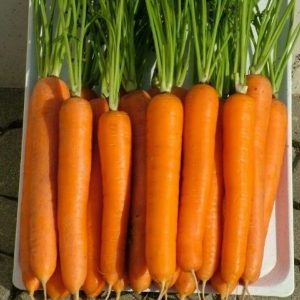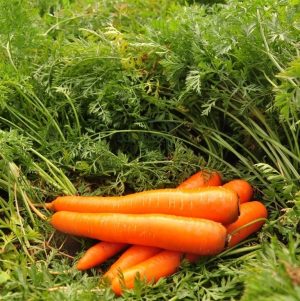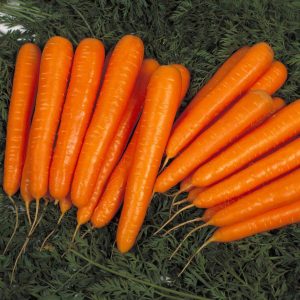Disease Resistant High Yielding Carrot Hybrid Laguna F1
Carrot hybrid Laguna F1 of Dutch origin is characterized by fast seed germination, high yield, resistance to many diseases. The culture is not too demanding to care for, but when growing it, it is important to properly prepare the soil and planting material. Let's dwell on the nuances of agricultural technology in more detail.
The content of the article
Description of the hybrid, origin and development
Laguna F1 is an early ripe hybrid with an excellent taste of root vegetables, universal in use.
The hybrid was bred by Dutch breeders from the company Nunhems B. V. In 2007, it was entered into the State Register of the Russian Federation.
Important! Since this is a first generation hybrid, the plant characteristics are not preserved during subsequent planting.
Composition and properties
Carrots are a useful root vegetable, which contains fiber, vitamins C, K, group B, essential oils, sterols, potassium, phosphorus and other trace elements.
Reference. The carotene content of the hybrid is average - up to 17.2 mg per 100 g of product.
Due to its rich chemical composition, the vegetable is used not only in cooking, but also in cosmetology, medicine, since it has anti-inflammatory, antiseptic, choleretic effects.
Ripening period and yield

Lagoon is an early maturing culture. Seeds germinate 8-10 days after planting. The ripening period for carrots is 80–85 days.
A high-yielding hybrid. The average indicator is 6 kg per 1 m2; subject to all agrotechnical techniques, up to 8 kg of vegetables are harvested. With prolonged cold snaps, the yield decreases.
Disease and pest resistance
The hybrid has strong immunity to the main viral and bacterial diseases, but with improper care, high humidity, it is prone to septoria, black rot. Among insect pests, aphids are dangerous.
Specifications
The leaves of carrots are medium in size, finely and medium dissected, with a rich emerald color.
The root crops themselves are cylindrical, oblong. Length - up to 25 cm, diameter - 2.5-3 cm. Average weight - 120-130 g. The core and bark of carrots are bright orange, the taste is excellent.
For which regions is it suitable
The hybrid is grown in Ukraine, Belarus, Russia. Cultivation is preferable in regions with temperate and continental climates. The lagoon is zoned for the North Caucasian region, but it is also planted in the Urals: the vegetable ripens quickly, until it gets cold.
Main advantages and disadvantages
The main advantages of the hybrid:
- use for winter sowing;
- fast germination;
- early harvest - 2.5–3 months after planting;
- culture resistance to major diseases and pests.
Among the disadvantages are the exactingness of the soil and the short shelf life of the crop.
Differences from other varieties
There are various options for planting the F1 Lagoon, including before winter. Fruiting of the crop is long: under favorable weather conditions, there is the possibility of re-harvesting.
Features of planting and growing
The hybrid requires pre-planting work, including the preparation of seeds and soil, adherence to planting dates and crop rotation rules.
Preparing for landing
The seeds of the hybrids have already been treated by the manufacturer from diseases and pests, but for reliability, some vegetable growers prepare the planting material on their own:
- sort it by size;
- remove damaged copies;
- disinfected in a weak solution of potassium permanganate;
- quenched for several hours in a refrigerator in a damp cloth.
This will make the carrots more resistant to both disease and environmental conditions.
Ground requirements
For the normal development of carrots, clay-sandy soil is suitable. Good is growing Lagoon and peat bogs. A suitable acidity level is 6 to 6.5 pH.
10-14 days before the date of planting, the soil is prepared:
- loosen the ground to a depth of 20–30 cm, remove weeds;
- add 100 g of superphosphate per 1 m2 of plot, dig up the soil with it.
Predecessors
Carrots grow well after:
- nightshade (potatoes, tomato);
- pumpkin (cucumbers, zucchini, pumpkin);
- legumes;
- Luke, garlic;
- spicy herbs;
- cabbage.
Poor predecessors are parsley, dill, cumin, beetroot and celery. These cultures "endow" each other with similar diseases.
Landing time and scheme
Planting is carried out in the spring, from the first half of April to May, or in the fall, until mid-October.
The scheme is standard:
- Grooves are made in the ground up to 4 cm deep.
- Seeds are planted at a distance of 3-4 cm from each other, at least 20 cm is left between the rows.
- The grooves are covered with soil.
Growing features
It is important to monitor the groundwater level in the area: they should not come closer than 1 m to the surface.Otherwise, you will have to plant carrots in the fall, because in the spring, due to melting snow, the seeds will be washed out of the garden.
The nuances of care
The lagoon is unpretentious, but in order to obtain a high-quality harvest, it is important to observe some peculiarities for caring for a hybrid.
Watering mode
Carrots are a moisture-loving culture... Water the plants regularly, but do not overmoisten.
For the first time, the beds are irrigated before planting seeds: for every 1 m2, 2.5–3 liters of water are used. Two weeks later, when the first shoots appear, the work is repeated. 8-10 liters of water are added for each meter of the bed. Watering is stopped 10-14 days before harvesting.
Thinning and weed control
Weeds are dangerous for carrots because they grow faster and drown out plantings. Therefore, the beds are weeded on time, preferably after watering, in order to saturate the root system with oxygen. The first time this is done 1.5–2 weeks after the emergence of shoots, the next - after 10 days.
Attention! During the first weeding, a free space of 2-3 cm is left between the plants, with the second - up to 6 cm.
Thinning is an important step in carrot care. It is carried out with a strong thickening of the plantings so that the plants receive a sufficient amount of nutrients, sunlight, and the roots are not deformed.
Top dressing
A month after planting carrots, fertilizers are applied with sodium and potassium. They will prevent the development of root rot, which occurs due to waterlogged soil.
During the period of active development of the culture, humus-based compositions are used, which will provide vegetables with the necessary nutrients.
Disease and pest control
The signs of the main diseases and the appearance of pests to which the hybrid is susceptible, the control measures are presented in the table.
| Name | Description and methods of treatment |
| White spot, or septoria | The disease occurs due to high humidity and high temperatures.
The main feature is the formation of white streaks on the tops. To get rid of the disease, plantings are treated with Bordeaux liquid 2 times with an interval of 10 days |
| Black rot, or alternaria | It is rare. It appears as black spots on carrots.
There is no specific treatment: the affected root crops are destroyed. For prevention and protection, plantings are treated with fungicides. |
| Aphid | The most dangerous pest for crops. Small, up to 5 mm, green insects are located on carrot stalks, sucking the juice out of them. As a result, the leaves wither, the roots are deformed and shrink.
If aphids are found, the planting is treated with a garlic or soap-ash solution, ammonia, insecticides. |
Harvesting and storage

When picking root vegetables, proceed with caution: any damage to the carrots will reduce its keeping quality.
Carrots are harvested twice within 2-4 months after planting the seeds. To do this, carefully remove the roots, cut the tops, stepping back 3 cm from the base of the vegetable.
The crop is stored in a basement or cellar at a temperature not exceeding + 5 ° C. The term is 4-5 months.
Growing difficulties
The main difficulty in cultivating a hybrid is the deformation of root crops, their loss of presentation when they are planted in an insufficiently prepared area. For this reason, the soil is plowed deeply before planting, fertilized, and all plant residues are removed.
Tips from experienced gardeners
The culture is moderately demanding to care for. When growing it, it is enough to follow the basic rules of agricultural technology for the preparation of seed material, soil, and also:
- adhere to crop rotation: do not plant a crop where plants from the same Umbrella family previously grew;
- timely fertilize;
- disinfect the soil before planting.
To keep the harvested crop longer, roots are harvested in dry, sunny weather. Better to put the crop in boxes of sand.
Reviews
Reviews of gardeners about Lagoon f1 will help you better know the hybrid, its advantages, disadvantages and cultivation features.
Dmitry, Moscow: "The advantages of the Laguna hybrid include high yield, beautiful fruits in shape: they turned out to be even, identical, without damage. I am engaged in growing for sale, carrots suit all characteristics. "
Andrey, Oryol: “Despite the fact that Laguna f1 is a rather demanding hybrid in terms of growing conditions and care, I still plant it on the site every year. Among the advantages I would like to point out early harvest, excellent presentation and taste of vegetables. "
Conclusion
The Laguna carrot hybrid is popular among gardeners due to its resistance to major diseases and pests, high yield, marketable appearance and sweet taste of root crops. The culture is early maturing with long-term fruiting, therefore it is grown not only in regions with a warm and temperate climate, but also in short summer conditions.
The main disadvantages of the hybrid are low keeping quality, exactingness to the soil, the need for pre-planting preparation. But most reviews about carrots are positive, so we strongly recommend that you try to grow it on your site!